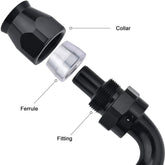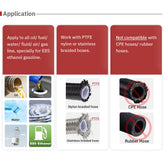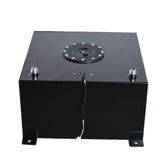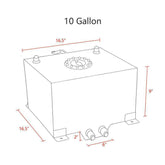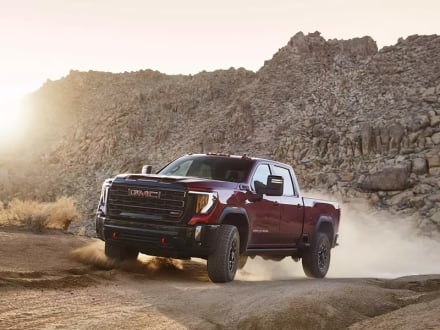The upper control arms play an important role in maintaining vehicle stability, handling and ride quality by controlling the vertical movement of the suspension and absorbing road shock. This also helps ensure that the wheels stay aligned with the steering system, which is essential for safe and efficient vehicle operation.
The difference between Upper Control Arms from Lower Control Arms
It's important to recognize the differences between the upper and lower control arms because they have different purposes. Lower control arms are in charge of regulating horizontal movements while higher control arms govern the vertical movement and alignment of the wheels. In order to offer stability and control throughout turns and different road conditions, both control arms cooperate.
Components of Upper Control Arms
They are made up of three main parts: bushing, body and ball joint.The control arm body connects to the vehicle frame through bushings (usually rubber bushings) and connects to the wheel side of the vehicle suspension using ball joints.
Exploring the Role and Function of Upper Control Arms
geometry and stability of the suspension
For the suspension system to ensure stability and safety while driving, appropriate geometry is essential. The tilt of the wheels with respect to the vertical axis is referred to as camber angle, and upper control arms are crucial in regulating this angle. Overall stability is improved by proper camber alignment, which guarantees that the tires keep ideal contact with the road surface while cornering and braking.
Increasing Wheel Alignment and Movement
The wheels move vertically as the suspension travels to smooth out road irregularities. Upper control arms enable controlled wheel movement, ensuring the intended path is followed and reducing negative effects like tire wear and traction loss.
Performance Affects Steering and Handling
A vehicle's steering response and handling qualities are strongly influenced by the design and state of its upper control arms. Upper control arms that are worn out or damaged can hamper handling, cause uneven tire wear, and put the safety of the driver at risk.
Signs of Upper Control Arm Wear or Damage
Normal wear and tear over time can cause upper control arms to degrade, which can cause the suspension system to become loose or play. In such circumstances, it is frequently required to replace the upper control arms in order to restore the appropriate operation and performance of the car's suspension system. You might need to replace the upper control arms for the following reasons:
- Ball joints that are worn out or damaged can happen as a result of difficult driving conditions or collisions. The ball joints on the upper control arm can become damaged or wear out over time. Worn ball joints can make the car handle badly, generate clunking noises, and even cause the driver to lose control of the steering.
- Control arm that is bent or damaged might happen as a result of collisions, challenging road conditions, or worn-out bushings. Poor handling, uneven tire wear, and even a loose wheel when driving might be caused by a bent or damaged control arm.
- Worn or damaged bushings, Over time, the upper control arm's bushings may get worn or damaged, which will affect how the vehicle handles and how it sounds when turning or navigating bumps.
- Upgraded performance, You might need to swap out the factory upper control arms for performance or adjustable ones if you're upgrading your car to make it handle better or fit bigger wheels and tires.
Benefits of Replacing the Upper Control Arm
Better Handling and Steering: Replacing a worn-out upper control arm will bring the wheels and suspension back into normal alignment, which can enhance handling and steering response. This may help your car feel more solid and manageable while you're driving.
Smoother Ride: A worn-out upper control arm can create jolts and vibrations when driving, making for an uncomfortable or harsh ride. A smoother ride can be achieved by replacing the upper control arm, which can help absorb shock from the road.
Longer Life of Suspension Components: Ball joints and bushings, for example, can experience severe wear and tear as a result of an upper control arm that is worn out. The lifespan of these parts can be extended and the possibility of future expensive repairs decreased by replacing the upper control arm.
Increased Safety: The handling, steering, and stability of your car can all be negatively impacted by a worn-out upper control arm. Your car can be made more reliable and safe to drive by getting a new upper control arm.

How to replace the upper control arm
Necessary Tools and Equipment:Gather the necessary tools and supplies, such as jack, jack stands, socket set, ball joint separator, torque wrench, and a suitable replacement upper control arm., before starting an upper control arm replacement.
Safety Precautions:When working on a car, safety should always come first. Use wheel chocks to keep the car from rolling, make sure the car is parked on a level surface, then raise the automobile safely according to the manufacturer's instructions.
- Make sure the area where you park is level. After that, use a jack to raise the car, and use jack stands to support the chassis.
- Place a marker where the upper control arms are. On the wheel that matches the upper control arm you wish to replace, loosen the lug nuts. And take out the wheel, setting it aside.
- Using a ball joint separator or pickle fork, loosen the ball joint nut. Then, carefully remove the ball joint from the spindle using a pry bar.
- On the bushings, loosen the nuts. Additionally, use a socket wrench or other appropriate tool to remove the mounting nuts holding the top control arm in place. Make sure you record the location of any washers or additional parts that are taken out with the bolts.
- Using a pry bar, remove the top control arm from your car's chassis.
- Reverse the steps you took to remove the old control arm and install the new one, then reconnect any additional parts. Verify that the control arm is positioned correctly and that all of the bolts are tightened to the recommended torque. For instance, zerk fittings, which are composed of copper that is brittle, are a feature of certain upper control arms. Use a torque wrench to tighten the zerk fittings after lubrication, being careful not to overtighten.
- After changing the wheel, lower the car.
- Before you hit the road, take the car for a test drive to make sure everything feels and works as it should. Take note of any strange noises or sensations, and how the steering feels. Before continuing, stop the car and check the suspension system if you see anything unusual.
Conclusion
In conclusion, maintaining a safe and comfortable driving experience depends on knowing the importance of upper control arms in a vehicle's suspension system. These crucial parts play a crucial part in regulating wheel alignment, stability, and movement, which directly affects steering response and handling performance.



